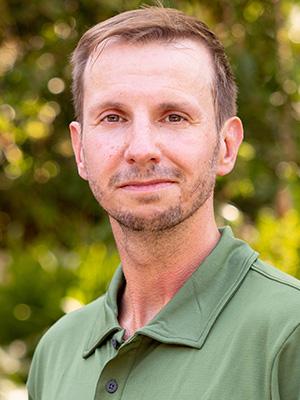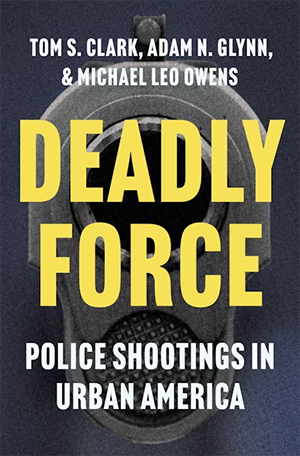Deadly Force explores when, where, and whom police shoot in America’s largest cities
New book is an effort to place facts before policy debate, while also making the call for greater police department transparency.
By Sarah Steimer

As debates have raged for years over how, or whether, to reform policing, a crucial piece of information has been missing: What do we really know about the use of deadly force by officers in the U.S.? What facts are actually available on which to base policies?
“I'm committed to the view that there is truth in the world and, and I think that sometimes what we need to do — before we have our debates and figure out how to advance our values — is to figure out what the truth of the matter is,” says Tom Clark, the David and Mary Winton Green Professor in the Department of Political Science.
“History is replete with examples of unintended consequences when people try to reform the government. One way to avoid that is to start with as much evidence as you can about how the world is before you try to change it.”
Around 2017, when protests about police violence became more sustained and scholarship grew around the topic, Clark — with Adam N. Glynn and Michael Leo Owens, both professors of political science at Emory University — felt there was a dearth of more rigorous and systematic research on the use of deadly force. They wanted to determine the basic facts of police shootings: the when, where, and whom.
“You can't have serious academic and policy debates until you have the facts straight,” Clark says.
Their efforts to understand those facts led to a new book, Deadly Force: Police Shootings in Urban America.
The authors looked to answer foundational questions that Clark says criminologists have long pointed to as critical data to which the public should have access. This data included information on who is being shot, where they are being shot, who's doing the shooting, whether the person is armed, and if they survive the shooting.
The research team sought answers from the 309 largest cities in the country, or those with a population of at least 100,000 people. With a grant from the National Science Foundation, they hired a postdoctoral researcher to facilitate the data collection and spent several years filing open records requests that asked police departments for records from every time an officer had discharged a weapon.
The data collected varied significantly, ranging from the information that the departments provided to whether they were willing to release data at all. About 100 departments refused to provide their records, sometimes pointing to obscure, vague provisions in the open records law. Some cities claimed not to have information on the whereabouts of shootings or the date, and still others didn’t have information on the subject of the shooting. Some departments consider the fact of a police shooting to be part of a personnel record and withheld information about the officer in certain cases.

“One of the key pieces of information we wanted to know was whether a suspect was armed, and we learned that information in only about three out of every 10 shootings,” Clark says.
The team made a list of every shooting that happened across these cities and filled in what information was made available to them. One chapter in Deadly Force is devoted to asking whether there’s evidence that the police are hiding information. In Texas and California, for example, the states compel every police department to share police shooting information with the state attorney general: It must be reported routinely and in a consistently formatted manner. When some police departments in those states refused to give Clark and his coauthors information, the team was able to look at different departments from the same state that did provide their records to see how they differed — and why.
In a high-level analysis of the data, the researchers looked at the predictors of how many shootings happen in a city each year. The major finding in this instance is that as violent crime goes up, police shootings become more common; however, as police departments get larger, there are fewer shootings.
“[In this case] our inference is largely that police officers have the resources and the capacity to be able to deal with confrontational situations without resorting to lethal force,” Clark says.
Looking within cities, the team explored where shootings were more likely to happen. The neighborhoods with the highest rates of shootings had more poverty and more violent crime. They also find that as violent crime goes up, police shootings increase — but they found this to be particularly true in neighborhoods with larger Black and Hispanic populations. Police respond to crime more violently in neighborhoods with larger Black and Hispanic populations.
Next, they looked at the individuals who were shot. They found that a city’s Black population is far overrepresented relative to their size among the city's population, relative to their size among the criminal suspect population, and relative to their size among the violent criminal suspect population. Most people being shot are armed (mostly with guns), but there are also many unarmed shootings.
White men, regardless of age, are more than 95% likely to be armed if shot. A 50-year-old Black man is more than 92% likely to be armed. But an 18-year-old Black man is only 77% likely to be armed.
“Another way of putting it is, if someone is unarmed and shot, they are most likely to be a young Black man,” Clark says.
Lastly, they analyzed fatalities. About 60% of police shootings are nonfatal, and Clark underscores that focusing on high-profile instances of fatal police shootings actually minimizes or distorts downward the overrepresentation of Black men among subjects of police shootings.
“We use the data to estimate how much racial bias there is in the decision to shoot, and we estimate that between 10 and 30% of all Black people shot would not have been shot had they been white,” Clark says.
Clark and his coauthors wanted to take the blindfold off of three key issues: First, they wanted to offer a better understanding of how many people the police are shooting. Second, they wanted to explore the role of nonfatal shootings, as the vast majority of police shootings are nonfatal, and how this distorts the public views. Lastly, they wanted to provide a better picture of the person involved in the typical shooting, versus what receives media attention.
“One of the big conclusions is that there should be more transparency,” Clark says.
“Police officers are ubiquitous government representatives. If you're going to come into contact with a government representative, it's probably a police officer, and they're authorized to take your life. That's the most awesome power that the government has. It seems objectionable to me that it’s something the government could do that I would have a hard time learning about. We all have a right to know when a government representative decides to use lethal force against a person in the country.”
 THE UNIVERSITY OF CHICAGO
THE UNIVERSITY OF CHICAGO

